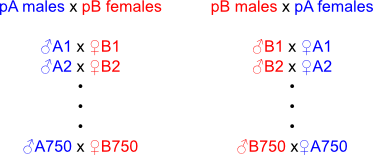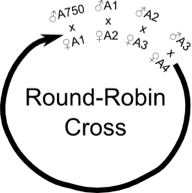Our analysis package will ultimately support the following experimental designs:
1) Phenotype homozygous RILs directly
This design is simple and only involves measuring the focal phenotype on one or more individuals from each genotyped RIL. In this case, all individuals scored are homozygous for nearly all loci (not typically the case for diploid organisms). Because the lines are inbred, this design carries with it the risk of mapping QTL for inbreeding depression in addition to QTL for the focal trait.
2) Phenotype RILs from matched crosses between the two populations
This design utilizes heterozygous individuals. These
individuals are created by crossing the set of RILs derived

3) Phenotype RILs from round-robin crosses within synthetic populations

4) Phenotype the progeny from each RIL crossed to a standard strain
In this design, females of each RIL and males of a standard, inbred strain of Drosophila (RIL1 x STD, RIL2 x STD...RIL750 x STD) are crossed. The cross is performed in this direction (RIL females x standard strain males) such that the effect of X-linked QTL can be determined in both sexes. In this “backcross” type design all individuals are phenotyped as heterozygotes, although only two genotypes will be present at each locus (AA and Aa, or Aa and aa). An advantage of this approach is that the level of inbreeding depression is equivalent to that in a natural population, since a given fragment of a recombinant chromosome is always against the same region from an unrelated strain. In this panel genetic variation is reduced because every individual scored has a common chromosomal complement, however the background genetic variance (a contributor to the error variance) is also reduced. A particular concern with the approach is the selection of the “standard” strain that all the RILs are crossed to: Detection of fully recessive autosomal, or female-specific X-linked QTL is only possible if the standard strain harbors the recessive allele. Similarly, detection of partially recessive QTL will depend on the magnitude of the departure from straight additivity, and the allele harbored by the tester strain – some combinations will increase, and some will decrease power to detect the QTL relative to other designs.

